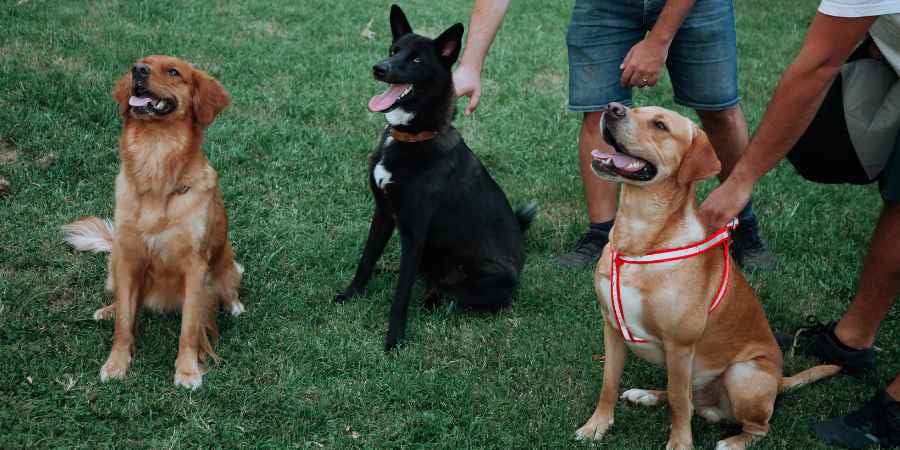How to Become a Dog Trainer: 5 Steps to Get Your Business Started
by Dakota Storage Buildings, on February 09, 2023

Dog training is an exciting and rewarding career. No day will be the same and it gives trainers flexibility to work around their schedule. Whether you are an animal lover looking for a way to incorporate that into their career, or a dog breeder with extra space and knowledge, starting a dog training business can be intriguing. In today’s blog, we are outlining everything you need to know about how to become a dog trainer.
1. Choosing an Area of Expertise
When you begin a career as a dog trainer, you must evaluate which types of training you want to offer. Different areas of expertise require different levels of training to ensure the pet is happy and healthy. Here are the most common types of trainers.
Puppy Training and Socialization
This is where most dog trainers begin and find their footing. Many owners want the puppy tendencies to end sooner rather than later, but they may not have the skill to help their dog learn the correct way to behave. Puppy trainers can help with anything from potty training to their demeanor around new people.
Obedience and Manners
This is the most common form of dog training. In obedience and manners, many of these dogs need to learn new skills that help them listen and obey their owners. Extensive training is not required for obedience and manners, making it another great place for new dog trainers to start out.
Therapy, Service, and Emotional Support Dogs
Therapy dogs require high levels of extensive training. For trainers wanting to go into this area, it is crucial to take courses and learn from others who are more experienced. These dogs must learn a variety of cues and commands to make sure they are prepared for any situation.
Adventure Training
Whether your client is planning to hike with their pet or simply take a stroll around town, these classes will ensure their dog is extremely well-behaved in the excitement. Off-leash training is often used for adventure training to ensure the dog is able to obey in public when they are not constrained.
Sport Dogs
If you have experience competing in dog shows with your pet, consider becoming a dog sports trainer. Your preexisting knowledge will help you teach others and will help your credibility with their owners. Many sports trainers choose one or two sports to be their niche instead of trying to teach everything.
Dogs with Phobias
Many dogs that were abused end up feeling fearful and anxious. Others were born with a phobic personality. Helping these dogs become more confident can be extremely rewarding. For compassionate and loving personalities, this expertise may be the best fit for you.
Dogs with Separation Anxiety
Experienced trainers are best suited to train dogs with separation anxiety. This panic disorder has become increasingly common and can hinder dogs from functioning properly when the owner has to leave. Working through this problem with pets can be life-changing for the dogs and the owners.
Aggressive Dogs
If you are considering a career as an aggressive dog trainer, make sure you are carefully evaluating this decision. This line of work is not suited for everyone and can be emotionally draining. These cases do not always have a happy ending and you could be pulled into court hearings for some cases.

2. Becoming a Pro
Before you begin teaching classes, you have to receive a form of education. Without it, you could cause more harm than good and can ruin your reputation.
Mentorship vs Classes
With any form of dog training, education is important. Many up-and-coming trainers today choose to find someone to mentor them. This allows them to receive hands-on experience and vital feedback. It also lets them build relationships with clients that could carry over when they start their own practice. One thing to consider about mentorship is that it can be sporadic and you are not guaranteed to work with them for a certain number of hours each week.
Another option is to get a formal education. Dog training schools offer in-person and online classes to teach you the ins and outs of the industry. These classes will typically follow a set curriculum This gives you an accurate timeframe for when you will finish training and can start your own business. Training schools can be a more expensive route. If you choose this method, make sure you conduct extensive research into the school to ensure that it is up to date on all the best practices.
What Makes a Professional?
Experience is key. Regardless of how you gain your education, it needs to be paired with hands-on learning. If you start a business but have never actually worked with a dog before, you will appear to be ill-equipped. It could hurt your credibility and you may not accomplish much. Having a history of success can go a long way in building your business.
As a dog trainer, you should never stop learning. Education is continuous in the industry and expanding your knowledge is critical to serve your clients well. Each year, consider taking courses, reading books, or attending seminars that can help you learn new tricks and deepen your understanding of different breeds.
3. Certifications Needed
Once you have the right experience, establishing your credibility is the next step. Joining a professional organization like the International Association of Animal Behavior Consultants (IAABC) or the Association of Professional Dog Trainers can give you access to new information and show your clients that you are serious about your profession. It is a great resource for industry trends and training developments. Many of these organizations have a public trainer locator database, which could help you obtain new clients.
While certification is not required, it is a way to prove your skills. Many certifications have a rigorous testing process. Being certified shows that you have relevant knowledge and experience within a specific area of expertise. It is common for applicants to write case studies, submit references, complete a course, have a minimum number of hours training, and take exams before they obtain the certification. Certificates and memberships to the organization can cost up to thousands of dollars but it is oftentimes worth the investment. Certificates help you stand out from competitors but can also help dictate what level of work and the number of clients you can take on at once.
4. Setting Your Services
The training style you choose will set the tone for your business. If you have a history in dog breeding, you will likely already have the kennel space for board-and-train or day training. Both of these class structures are for extended amounts of time. Board-and-train opens your home to dogs for several weeks, giving you the opportunity to work with them extensively and independently. Day training is similar to a daycare. You keep the dogs for most of the day, giving you the ability to work with them for extended periods without having to keep them overnight.
Two of the most popular forms of training are group classes and private lessons. Typically, what you imagine when you think of dog training are group classes. These meet in a public area and there can be up to six dogs, and their owners, in one class. Private training is another option that lets you work with a dog one-on-one for short periods of time. This approach can be flexible and the training can be catered to the dog’s specific needs.
5. Setting Up the Business
With any new business, it may take time before you reach a steady flow of clients. Getting your foot in the door is the first step to obtaining clients. Whether that is through veterinarian referrals, or working with another trainer, you must be proactive to obtain your first client. Partnerships with local veterinarians, groomers, and dog walkers can be beneficial since those professionals encounter dog owners every day. They may be able to refer to your services and can play a vital role in growing your business.
Promoting your business is essential for continued growth. It can be easy to plateau once you have established yourself. To ensure you are constantly expanding your reach, marketing is key. Traditional marketing like flyers, business cards, and word of mouth can be effective for small communities. However, for cities, consider utilizing modern technology to grow your client base. Social media profiles and a website can help establish your credibility, build relationships, and demonstrate your skills. Online communities are thriving and can be a great place for you to connect with pet owners.
Executing a business plan for your dog training service can be intimidating, but with hard work and strategic marketing, you can grow into a thriving, profitable business. Give your business a name so it can establish a brand for itself and become easily recognizable when people hear it. Finally, do not shy away from publicizing your success. Including google reviews, case studies, and testimonials on your website and marketing materials will go a long way in attracting new customers.
A Guide For All
We hope this has served as a detailed guide for anyone asking the question: how to become a dog trainer? Focusing on these areas and setting goals will ensure that you are on the right track. Building a solid foundation is essential for establishing credibility and building your reputation.
As a dog trainer, the pet’s comfort, happiness, and health is the primary concern. We created a guide, How to Ensure Your Working Dog is Healthy & Happy, to help you further your education about specific breeds. Check out this quick, yet detailed, to learn more about working dogs and their needs.

























